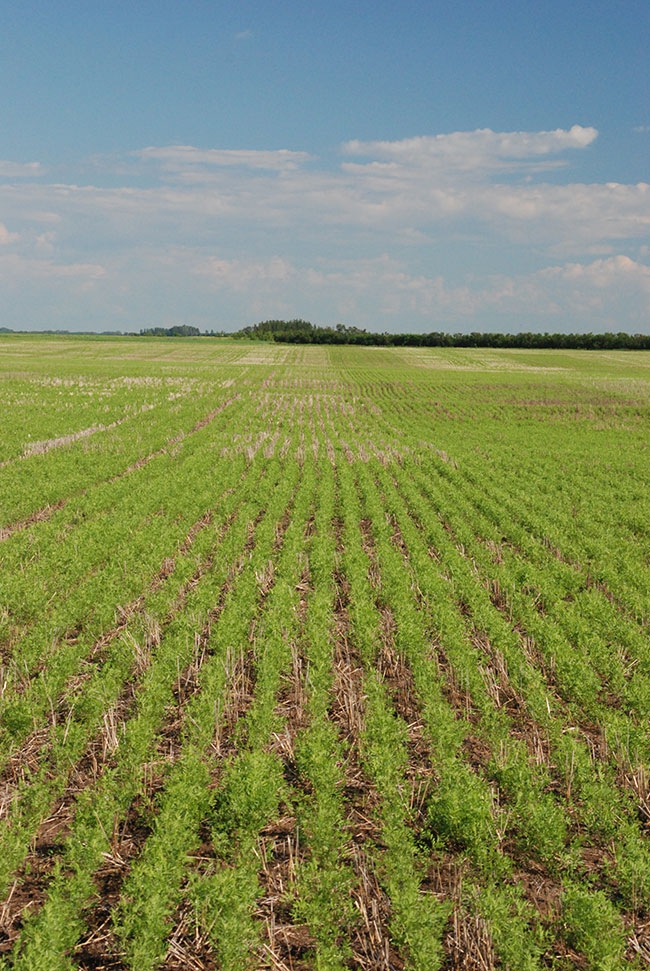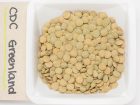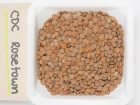
Features
Agronomy
Seeding/Planting
The search for the optimum lentil seeding rate
There are 10 different lentil classes with many different seed sizes, yet still only one general recommendation for a seeding rate of 130 seeds per square metre (seeds/m2), or 13 plants per square foot (plants/ft2). But with lentil seed sizes varying widely, ranging from 70 grams per 1,000 seeds down to 29 grams per 1,000 seeds, does that recommendation hold up with today’s varieties? Research is trying to find the balance between seed cost, disease levels, yield and economics. Add in the relatively poor weed competition provided by lentils and it’s clear why optimum stand establishment is critical for high yields and economic returns.
May 4, 2017 By Bruce Barker
 Increasing small and extra small red lentil seeding rates will help the crop canopy sooner There are 10 different lentil classes
Increasing small and extra small red lentil seeding rates will help the crop canopy sooner There are 10 different lentil classes“For a long time, lentil growers dealt with weeds with Sencor, but it was hot on the crop and had to be applied too early to provide the best weed control. Then we saw imidazolinone-resistant (IMI-resistant) weeds like kochia, wild mustard, wild buckwheat and red root pigweed develop, so we started to look at other ways of reducing the impact of weeds,” says Steve Shirtliffe, a professor with the department of plant sciences at the University of Saskatchewan.
In lentil, the critical period of weed control (CPWC) – the period when weeds must be controlled to prevent yield loss – was identified by Leah Fedoruk, Shirtliffe, and Eric Johnson, all at the University of Saskatchewan. In the research conducted in 2011, the CPWC was determined to be from the fifth to 10th node. This timing is essentially when the weeds start to accumulate significant growth through to crop canopy closure.
Subsequent research by Fedoruk and Shirtliffe looked at the best timing for IMI herbicide application in Clearfield lentil. This research compared herbicide application at either the two- or six-node stage of lentil growth. Application of IMI herbicides at the six-node stage resulted in 30 per cent higher yield than the two-node stage. Based on these results, an IMI herbicide application on Clearfield lentil was recommended at the five- to six-node stage of the crop.
“But Group 2 wild mustard is a huge nemesis for lentil production and the IMI herbicides were no longer effective on the resistant Group 2 weeds, so we started to look at agronomic practices like seeding rate to help control weeds,” Shirtliffe says.
Increasing seeding rate
Shirtliffe was involved in earlier research in 2005 and 2006 looking at seeding rates in organic lentil production. Large green CDC Sovereign lentil was sown on nine-inch row spacings. The research found seed yield increased up to 1,290 kilograms per hectare (kg/ha) or 1,148 pounds per acre (lbs/ac) with an increased seeding rate. Weed biomass was reduced by 59 per cent at the highest seeding rate of 375 seeds/m2 as compared with the lowest seeding rate. Economic return was maximized at $385 per acre at the highest density of 229 plants/m2, achieved with a seeding rate of 375 seeds/m2.
“This organic research trial got us thinking about how seeding rate and seed size impacted weed control, disease levels and yield in conventional lentil production. In organic production, increased seeding rate gave better weed suppression and higher economic return under really heavy weed pressure, so we wanted to look at the responses in conventional lentils,” Shirtliffe says.
Research by graduate student Colleen Redlick and Shirtliffe looked at an integrated approach to weed control in CDC Impala, an extra small red lentil, using seeding rate, herbicides and rotary hoeing. Seeding rates were 130, 260 and 520 plants/m2.
“We found that increasing seeding rate reduced mustard biomass and improved herbicide effectiveness. A lot of herbicides don’t work that well in lentil, so improving crop competition provides better weed control,” Shirtliffe says.
More recently, University of Saskatchewan graduate student Kali Kasper and Shirtliffe looked at the effect of seeding rate on lentil disease, weeds, yields and profitability in two separate experiments. In the first experiment, Kasper looked at two seeding rates of 120 and 240 seeds/m2 for extra small red, small red and large red lentil varieties. Fungicide treatments included Headline fungicide sprayed once, Headline sprayed twice, and Fracture fungicide sprayed once.
In the second experiment, Kasper looked at the optimum seeding rate for the different seed classes. Rates of 60, 120, 180, 240, and 320 seeds/m2 were planted across six different lentil classes: large green, larger red, medium green, small green, small red and extra small red. She is also looking at disease development and yield.
Shirtliffe says they are still analyzing the data from these two experiments, but taken in context with the other research trials he has conducted, he says there are some solid trends emerging.
“With seeding rate, there is pretty good evidence now that smaller red lentils seem to respond to a higher seeding rate than other classes. We haven’t done an economic analysis yet, but there is good agronomic data that shows seeding rate for small red lentils can be doubled from the standard recommendation of 130 seeds per square metre to 260 seeds per square metre,” Shirtliffe says. There was no weed effect on yield since the plots were hand-weeded.
Shirtliffe also says questions arise regarding what happens to disease levels with higher seeding rates and thicker crop canopies. In Kasper’s research, they noticed Sclerotinia disease levels increased with higher seeding rates in the three lentil classes of extra small red, small red and large red varieties, but not anthracnose and Ascochyta.
“We also found that applying fungicides twice instead of once gave higher yields when seeding rates were increased,” Shirtliffe explains. The trials were conducted in the relatively wet years of 2015 and 2016.
At one site, they sent an unmanned aerial vehicle (UAV) up to take crop stand density imagery. They noted that the smaller red lentil classes did not fill in the canopy as quickly as the larger seeded varieties. This has implications for weed competition and potential yield and may explain why seeding rate can be pushed for small seeded varieties.
“Typical with all crops, to get high yield, you want to get a full canopy to capture sunlight. Farmers and agronomists forget that sunlight is the most important input, so what you are trying to do with seeding rates and stand establishment is building a solar panel to help the crop [with photosynthesis],” Shirtliffe explains.
Taking all the research into consideration, Shirtliffe says that for extra small and small red lentil classes, he recommends the seeding rate could be doubled to 260 seeds/m2. For larger green and bigger red lentil classes, he says producers should stick to the standard 130 seeds/m2 seeding rate.
“For larger seeded lentils, there may be a yield advantage with higher seeding rates but the additional seed cost may eat up any yield benefit,” Shirtliffe says. He adds Sclerotinia may also be a risk for higher seeding rates, and that growers need to avoid cropping on canola and other host crop stubbles, and use fungicides to help manage diseases.
Seeding rate and stand densities
To achieve the currently recommended stand density of 130 plants per square metre for medium and large seeded classes, using a seeding rate based on thousand kernel weight is recommended. A similar calculation can be made for small seeded red lentil classes targeting 260 seeds per square metre.
The Alberta Agriculture and Forestry website has a seeding rate calculator that can provide a seeding rate based on thousand kernel weight.
Example 1: Large green lentil
- Target plant density: 12 plants per square foot (130 plants/square metre)
- Germination rate: 90 per cent
- Emergence mortality: 20 per cent
- Row spacing: 12 inches
- Thousand kernel weight: 66 grams
- Seeding rate required: 105.6 lbs/acre, resulting in seed placement of 16.7 seeds per foot of row.
Example 2: Small red lentil
- Target plant density: 12 plants per square foot (130 plants/square metre)
- Germination rate: 90 per cent
- Emergence mortality: 20 per cent
- Row spacing: 12 inches
- Thousand kernel weight: 34 grams
- Seeding rate required: 54.4 lbs/acre, resulting in seed placement of 16.7 seeds per foot of row.


